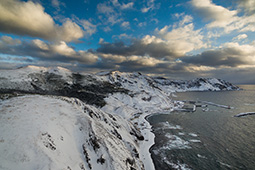INDEX
- English
- 日本語

Rebunshiogama, one of about 300 species of flowering alpine plants on Rebun Island - English
- 日本語

Mt. Rishiri viewed over a field of pink common bistort flowers

The yellow Rebun-kinbai-so globeflower (Trollius ledebourii var. polysepalus) is endemic to Rebun Island 
The coastline of Rebun Island in winter photographed by drone
November 2021
Rebun Island: A Magical Island of Flowers

Known as the “Island of Flowers,” Rebun Island, a remote island in the far north of the Sea of Japan, is home to approximately 300 species of flowering alpine plants. Christopher Browne, who lives and works on the island, and photographs its natural scenery through the four seasons, tells us about Rebun Island’s charm.

Beyond a field of alpine flowers steeped in pink, the outlines of a mountain peeking through a sea of clouds; towering green cliffs rising out of an indigo blue sea and a mass of dainty blue flowers in bloom. These are the scenes caught in scores of beautiful photographs taken on Rebun Island. The photographer is Christopher Browne, originally from the United States, but a resident of Rebun Island since 2010.
Rebun Island lies roughly sixty kilometers west of Wakkanai City, which is on the northernmost tip of Hokkaido, the northernmost of Japan’s four main islands, and has a population of around 2,400 (as of October 2021). The island measures approximately 7.9 kilometers from east to west, 25.8 kilometers from north to south, and the total area is about 81.3 square kilometers. The western part of the island has been designated part of the Rishiri-Rebun-Sarobetsu National Park. Rebun Island is also called the “Island of Flowers” because as many as 300 species of wild flowers bloom gloriously in a variety of colors from late May to August. Located at a latitude of 45 degrees 30 minutes north, Rebun Island has a cool climate where the annual average temperature does not rise above seven degrees centigrade. This is why alpine plants, which are normally only seen in mountainous regions at least 2,000 meters above sea level, flower at low elevations here. The species endemic to the island include the Rebun-atsumori-so orchid*, the Rebun-kinbai-so globeflower**, and the Rebun-usuyuki-so edelweiss***.

Browne moved to Rebun Island in 2010. Since 2013, he has worked as an assistant English teacher at the island school while continuing to photograph the seasons on the island.
“It was summer, in August 2005, when I first visited Rebun Island. I clearly remember how refreshed I felt walking along woodland paths through patches of wildflowers here and there, a strong scent of pine trees on the air.”
This was the experience that triggered his desire to move to Rebun Island.
There are six hiking trails on Rebun Island where walkers can observe various alpine plant colonies. Browne recommends the Momo-iwa Rock Observatory Route: “You can see the beautiful Mt. Rishiri (elevation of 1,721 meters) towering above the adjacent Rishiri Island from the Momo-iwa observation point. In May and June, a sea of clouds sometimes appears. The species of flower in bloom change every two to three weeks, so no matter how many times you visit there is always different scenery to enjoy.” He also recommends the Misaki-meguri trail on which walkers can observe different flowers on the way to the capes as they climb the hills. “In particular, the scenery around Cape Gorota is excellent,” Browne says.
June and July are the best months to see the flowers on Rebun Island. This is also the season for sea urchins, a Rebun Island specialty. It is a good season for a visit to enjoy both the beauty of the flowers and the delicious sea urchins. However, Browne says that autumn, when the season for flowers is over and the grasslands are aglow with the golden plumes of the pampas grass, is no less beautiful than the summer.
By December, the snow falls on Rebun Island and outside visitors stop coming. Nevertheless, wanting to showcase the nearly unknown beauty of Rebun Island in winter, Browne has published a photo collection entitled Rebun no fuyu (Rebun Winter) at his own expense. Donning snow shoes to make his way into snowbound mountains and forests, in numerous photographs Browne has chronicled the interior of Rebun Island, a snowy landscape wrapped in silence, and he also takes drone footage. He shows wild white-crested waves breaking against the cliffs and unspoiled natural scenery.

Both the gentle countenance of the Island of Flowers and its rough aspect during its harsh winter are true features of Rebun Island. This is the new charm of Rebun Island, presented by Christopher Browne, a resident who loves the island.
* (Cypripedium macranthos var. rebunense)
** (Trollius ledebourii var. polysepalus)
*** (Leontopodium discolor)

